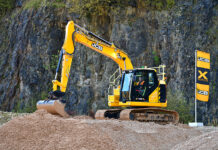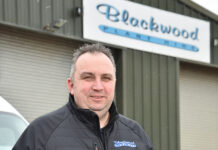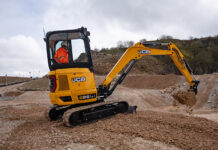
ROB Oliver has been chief executive of the CEA (Construction Equipment Association) for the best part of 20 years now. In that time, he’s seen a number of significant changes in the industry and, along with his colleagues, has been instrumental in raising standards in a variety of areas from the environment to countering plant theft.
Rob recently told Gary Moug about the role of trade associations in the modern world, opportunities that exist for the plant sector within the digital revolution, and the joys of setting up exhibition stands, including assembling flat pack furniture in the early hours of the morning…
Q) WHAT IS YOUR BACKGROUND? WHEN DID YOU FIRST BECOME INVOLVED WITH THE CONSTRUCTION EQUIPMENT INDUSTRY?
A) I started doing various jobs for the predecessor organisation back in the 80s. Before that I flirted with accountancy, politics, and did some charity work, which was actually quite helpful in doing the work within the trade association. So, I go back over 30 years now.
Q) HOW IMPORTANT DO YOU BELIEVE ORGANISATIONS SUCH AS THE CEA ARE? CAN YOU GIVE EXAMPLES OF THE TYPE OF THINGS YOU DO AND SOME OF THE TRADE BODY’S BIGGEST ACHIEVEMENTS?
A) I think they’re pretty important. If you look at the situation in the UK, there are something like 4,000-plus trade associations and professional bodies. They all do their bit to bring people together in a particular area of interest. If you don’t have a collective voice, then you quite often get rolled over by government or government agencies.
This might seem a bit strange in the age of Brexit but we’ve been able to offer a lead in the European construction equipment industry. We’ve made a big difference in making sure that legislation proposed by the European Commission is brought down to implementation phase with an element of reality rather than aspiration. We’re pleased we’ve made an impact there.
Also, a few years ago we did a survey of our members and one of the key things which came through was the problems relating to skills shortages. What we’ve done since is develop a really good partnership with Primary Engineer, an organisation that works with primary schools, as the name suggests, but also some secondary schools, in launching projects that the kids can use for their schoolwork. It just gives them an idea of the potential within the wider engineering world. That’s been very successful and Susan Scurlock, who runs that, received an MBE last year for her efforts.
The other thing we’ve done in the last couple of years in the area of education is we’ve had two trailblazer standards adopted, which cover machine servicing and maintenance. That was something we picked up on particularly from the distributors within our sector, where they needed a framework to train the people who actually work on the machines.
More recently we’ve entered into a partnership with the National Fluid Power Centre. We noticed some gaps in certain areas in terms of upskilling the existing workforce. Things change in our industry, for example there are now big blocks of digital applications. There are people who have been with companies for some time who maybe haven’t had that background and training that they need in that area. We’ve been working with the National Fluid Power Centre, not just on hydraulics, but a whole range of things, to offer our members some new courses. That’s an exciting and practical thing we can do.
Q) WHAT ARE THE BENEFITS OF JOINING AN ASSOCIATION SUCH AS THE CEA?
A) First of all, you get access to people who offer different elements of our service. We’re really lucky to have a guy called Dale Camsell who heads up our technical and regulatory team. They have regular meetings where they’ll review what’s coming up – it might be on news from Europe, it might be international standards, or it might be something that’s at a more local level. Because people can get around the table and discuss that through our facilitation, we can come up with an approach and then a response to the appropriate body to try and get that single voice. Divide and rule is something we want to avoid.
We’re also lucky to have Paul Lyons, who is our senior market analyst. He provides things like digests of the latest stats on the equipment market and the wider construction market, and the latest information on trends. He liaises with specialist suppliers of statistics. That is a service that members really appreciate because it gives them an insight into what’s going on. Although there’s a lot of stuff which is published and available on the Internet, not everyone has the time to do that search.
We’ve also done a lot over the years on the international trade front. We’ve been a partner of the Department for International Trade to organise British groups at trade shows overseas. You’ll always see us, for example, at bauma with 30 or 40 British companies. Further afield, we’ve been to over 20 countries either as trade missions or British groups at trade shows.
Q) THE CEA HOSTS THE PLANTWORX EXHIBITION. HOW VITAL ARE THESE KIND OF TRADE SHOWS FOR FIRMS IN THE EQUIPMENT SECTOR?
A) A lot of your readers will remember the old SED show, which ran for many years. That hit some difficulties during the last recession. When SED was cancelled one year, some of our members said they’d still welcome a biennial show and asked if there was anything the CEA could do. We got a team of our members together to look at what we could do. We started out very much with the principle of not to make it an all-singing, all-dancing show, but very much a working show where people could come and see the equipment demonstrated.

We’ve now done four shows, the last one was at East of England Event Centre, Peterborough. That was the first time we’d held the show at a permanent exhibition centre and that worked very well in terms of the logistics and facilities. We’re still dreaming of having a sunny Plantworx, as we’ve only ever had about one hour of sunshine in 12 days of these shows. We got through 4,000 ponchos in a day-and-a-half this year!
Plantworx is still supported very strongly by the bigger companies and key suppliers. It gives plant operators an opportunity to see what’s new in the marketplace. It’s a good meeting place. We’re just hoping for good weather next time!
Q) WHAT DO YOU SEE AS THE BIGGEST CHALLENGES AND OPPORTUNITIES FACING THE PLANT SECTOR AT THE MOMENT?
A) Over a number of years, successive governments have failed to provide to the industry a pipeline of major construction projects. The latest (issue) is the review of HS2. We’ve been talking to the project people for HS2 for something like ten years. We were excited for the project and the plans ahead, but now it is in danger of coming to a shuddering halt or being completely reformed or delayed. That just seems to be the story in our country. You have something like the Heathrow expansion, which has been talked about for 40 years and is still by no means certain to go ahead.
I know it’s not a fair comparison, but I looked up some stats the other day. In this year alone, China is investing in 4,000 miles of new rail track and by 2035 they’ll have over 200 new airports, while we dither about finding room for one runway. It’s a different situation, I know, but it does really underline the frustration that we get. It’s not all about what governments can do but it would help if things like the Infrastructure Commission was able to give a proper lead without too much political interference.
The thing that stands out on the benefits side is that we’re in the middle of a digital revolution. For example, CECE has a project which is aimed at creating a digital roadmap for the construction industry. A lot of people will be familiar with BIM, a lot of people will be familiar with telematics and the different systems that are available to monitor performance and provide information and data, but there’s still not a common platform. I think both the opportunity and the challenge as we go forward is to develop common platforms so that, for example, if you’re a plant hire company with a mixed fleet, you can get compatible data coming back for your machines and the machines can talk to each other in the same language. In the same way that when we had early computers, they didn’t talk to each other because they were running off different operating systems. Before too long, we got some standardisation and now we think nothing of sending an email from A to B whereas 30 years ago it was impossible if they weren’t on the same system.
Other things include autonomous operation of plant, which is with us now.
Our sector has seen a revolution in the reduction of the level of gas and particulate emissions from machines. Our equipment has never been ‘greener’, even before the gradual introduction of hybrid and electric machines. The challenge ahead will be in the area of CO2 which is likely to be the prime focus for legislators going forward.
Q) WHAT SHOULD THE INDUSTRY BE DOING TO ENCOURAGE MORE YOUNG PEOPLE TO CONSIDER CAREERS IN THE SECTOR?
A) I mentioned earlier some of the work we’ve been doing with schools through Primary Engineer, which has been very valuable. Also, we very much encourage our members to work within their local communities to reach out to local schools and colleges.
I think now, and this touches back on the point about digitisation, is that years ago someone who worked on a construction machine as a service engineer would come along with heavy boots and a big toolkit. Now it’s very much a spanner in one hand and a computer in the other. In fact, sometimes they don’t have to even leave their office to do diagnostic work on a machine. That’s what we’re trying to get across now to people who might be might be interested in joining the industry. It’s not all yellow hard hats, it’s actually far more sophisticated now than it was 20 or 30 years ago.
What was really encouraging was we had our Simulation Zone at Plantworx, where we had what I think was a world first – seven different simulators linked together to simulate a construction site. That was so popular that people were queuing up to have a go. That was where the younger visitors really accumulated because they’re used to their game stations. That’s very much the direction of travel now; it’s just to show that what we have to offer is technologically quite sophisticated.

Q) WHAT ARE THE HIGHLIGHTS OF YOUR TIME AS CHIEF EXECUTIVE OF THE CEA?
A) We’re on course this coming year to triple membership compared to when I took office as chief executive, which was about 20 years ago. Linked to that, I’m also quite pleased that for the past seven or eight years we’ve never actually increased the subscription scale. If anything, it’s gone down over that period.
There’s the CESAR scheme, which we started 12 years ago when we took the lead in setting up a register of construction plant with the triangle marking on the machines. We were able to help support a new national police unit at that time, and a successor organisation we’re involved in setting up, which will probably be going live in the New Year.
There’s something like 330,000 machines now on our CESAR database. We’ve come a long way from when companies were saying that we didn’t need to do anything about plant theft.
There’s a lot of activity now in and around countering plant theft, not just from the police but also individual companies.
Another thing I’m proud of is on the international sector and the number of companies we’ve been able to take to their first trade show who have made a success of exporting. Any number of them have won Queen’s Awards for international trade.
Q) ANY FUNNY ANECDOTES FROM YOUR CAREER?
A) When I used to do the trade show groups, back in the day when things weren’t as sophisticated in terms of how they were put together, I had a number of disasters. I had one group of 30 companies in an outside area at the bauma show. Everything looked beautiful on the first day of the show – nice sunshine, layout was great, signage was spot on. On the second day it poured with rain and I found our contractor had used oil-based paint for all the signs, which washed them away, so I had 30 companies banging on my door to complain.
Another time there was a delay in putting some stands together. It was 1am and everything was complete with the exception of stand furniture. The lorry arrived and when we opened it up, we discovered it was flatpack furniture – we had to put something like 120 chairs together, which took two-and-a-half hours, so we very nearly saw dawn that morning.
One year I was asked to present at the SED show. I prepared for a very serious and informative talk on the latest directives coming out of the EU that were of great relevance to the industry. I had my usual audience of six people and a dog when, about five minutes in, a brass band set up camp on the other side of the tent where I was speaking, and no one could hear what I was saying!
Q) HOW DO YOU RELAX WHEN YOU’RE NOT WORKING?
A) At my time of life, gardening’s got its appeal now. I own a share in a winning racehorse, so that’s quite an enjoyable little hobby.
I also like country music – the one thing that I’ve been known to spend money on is leather cowboy boots, which is what I’m wearing at the moment.








